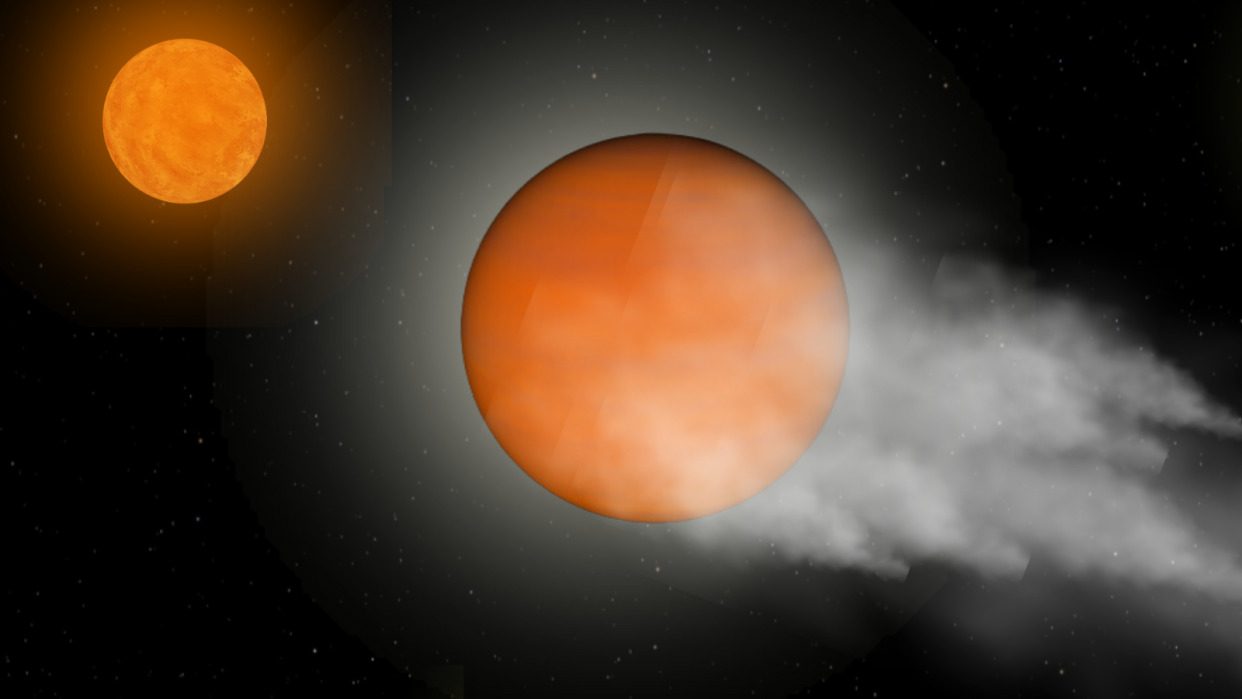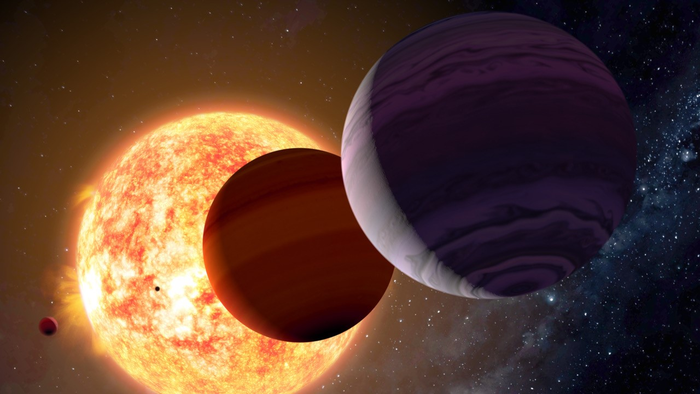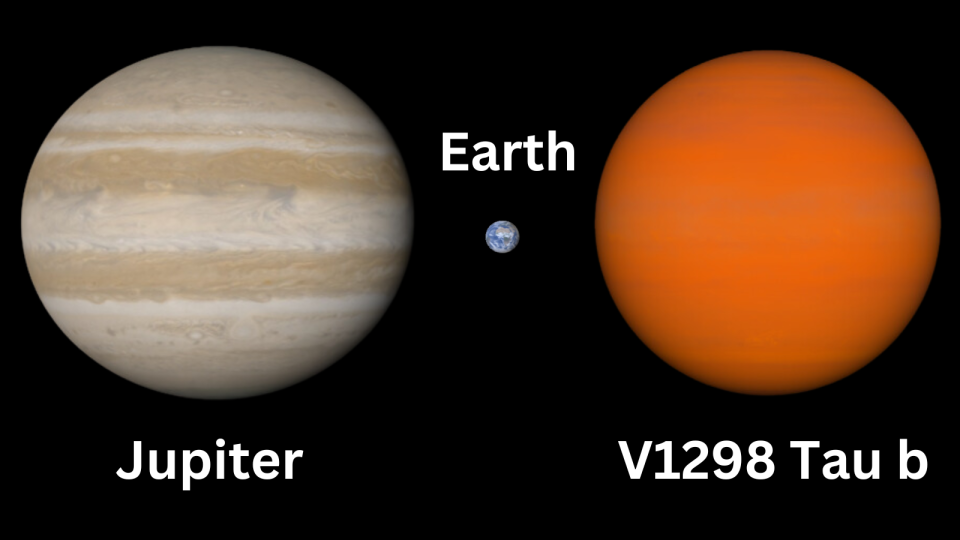Young 'cotton candy' exoplanet the size of Jupiter may be shrinking into a super-Earth

Using the Hubble Space Telescope, scientists have discovered that a cotton-candy-like Jupiter-sized planet located around 350 light-years away is shrinking and could be on the way to becoming a "sub-Neptune" or "super-Earth" sized world.
As well as being one of the lightest planets ever discovered, the extrasolar planet or "exoplanet" called V1298 Tau b also happens to be one of the youngest worlds ever discovered as it crosses or "transits" the face of its star.
V1298 Tau b orbits a roughly 23-million-year-old star, which is an infant relative to older stars such as our middle-aged star, the sun, which is 4.6 billion years old. It is accompanied in this system by at least three other planets, V1298 Tau c, d, and e. This means that this system offers astronomers a unique opportunity to study the atmospheres of freshly formed and evolving planets.
To do this, the team used the Hubble Wide Field Camera 3 (WFC3) instrument to observe V1298 Tau b as it transited the face of its young parent star, classified as a T Tauri star, which means it is a very young star with a sun-like mass.
Related: Cotton candy exoplanet is 2nd lightest planet ever found
"V1298 Tau b is the size of Jupiter. However, we found the mass of this planet to be comparable to, or even lower than, that of Neptune," research team leader Saugata Barat from the University of Amsterdam told Space.com. "Therefore, it is likely to be a Neptune or Sub-Neptune progenitor at this age. Depending on the evolution of this planet, it could lose a large chunk of its primordial atmosphere and end up as a sub-Neptune or potentially even a super-Earth-like planet."
Because Jupiter is roughly 20 times the mass of Neptune, the fact that V1298 Tau b is the width of the former with the mass of the latter means that this exoplanet is incredibly "puffed out," as astronomers currently see it.
"V1298 Tau b is one of the lowest density planets we have discovered thus far. Its density of 0.1 grams per cubic centimeter can be compared to cotton candy," Barat added.
Decoding the shrinking atmosphere of V1298 Tau b
Using its transits, the team performed an atmospheric investigation of V1298 Tau b and discovered a large and clear atmosphere extending out for around 621 miles (1,000 kilometers). This is much wider than the atmospheres of solar system bodies like Saturn's largest moon Titan, which have atmospheres that extend out from their main body by between 31 miles and 62 miles (50 to 100 kilometers).
V1298 Tau b is just around 16 million miles from its highly active, hot young T Tauri parent star, meaning that it completes an orbit in just 24 Earth days. As a result of this proximity, the planet is also being bombarded with high doses of ultraviolet and X-ray radiation from its star, which is stripping its atmosphere.
Additionally, the team found the interior of this planet to be very hot, though it is expected to cool down as it matures, which is also adding in the loss of atmosphere.
"A combination of these processes is likely to drive significant mass loss and contraction for this planet," Barat said. "A comparison between the nature and composition of V1298 Tau b with mature sub-Neptunes highlights significant differences. Therefore, it is possible that in due course of its evolution, the atmospheric composition and chemistry of V1298 Tau b might also change."

As a result, V1298 Tau b tells astronomers that when Neptunes and sub-Neptunes first born in a cloud of gas and dust surrounding a young star called a "protoplanetary disk," they are in a state that doesn't resemble how they appear at mature ages. The research also suggests Neptune and sub-Neptune-class planets may shift positions in their planetary systems.
"They are born with significantly large primordial envelopes, likely to have been accreted while they were forming within a proto-planetary disk," Barat said. "By analyzing the atmospheric contents of V1298 Tau b, we think that this planet may have originated close to its current location close to its host star."

Because elements and chemical compounds absorb and emit light at characteristic wavelengths, analyzing the light that passes through the atmosphere of the planet as it transits the face of its star using a process called spectroscopy can reveal its composition.
For V1298 Tau b, this investigation uncovered something unusual about this exoplanet's atmosphere. It is surprisingly low in "metals," which is the term astronomers use for elements that are heavier than the universe's two lightest elements, hydrogen and helium.
"We were surprised by the non-detection of methane. The temperature of this planet is ideal for the production of a large amount of methane," Barat said. "However, its absence points towards chemical processes in its atmosphere, such as strong vertical mixing, which can remove the methane from the observable atmosphere.
The University of Amsterdam scientist went on to explain that methane can only be removed if a planet's interior is very hot. The missing methane in the atmosphere of V1298 Tau b led them to hypothesize that the temperatures in the planet's atmosphere are 80 degrees Fahrenheit (27 degrees Celcius) or greater. By comparison, the average temperature of Jupiter's atmosphere is minus 166 degrees Fahrenheit (minus 110 degrees Celcius).
Related Stories:
— Doomed egg-shaped exoplanet is death-spiraling into its star
— Earth-size planet discovered around cool red dwarf star shares its name with a biscuit
— Star blows giant exoplanet's atmosphere away, leaving massive tail in its wake
Barat said that the current observations only observed water vapor in the atmosphere of V1298 Tau b. This means in the future, they intend to measure the abundance of other molecules, such as carbon dioxide, carbon monoxide, and sulfur dioxide, to complete an inventory of chemicals present in the atmosphere of this exoplanet.
"It is important to precisely constrain these abundances as it ties directly to the location of formation for this planet," Barat added. "It is also important to investigate the impact of the host star on the planet's atmospheric chemistry."
Barat and colleagues have obtained observations of V1298 Tau b with the James Webb Space Telescope (JWST), which they are currently analyzing.
"The JWST is sensitive to a wide array of molecules such as water, methane, carbon dioxide, carbon monoxide, and sulfur dioxide. Thus, we will soon be able to address these questions," Barat concluded.
The team's research was published on May 9 in the journal Nature Astronomy.

